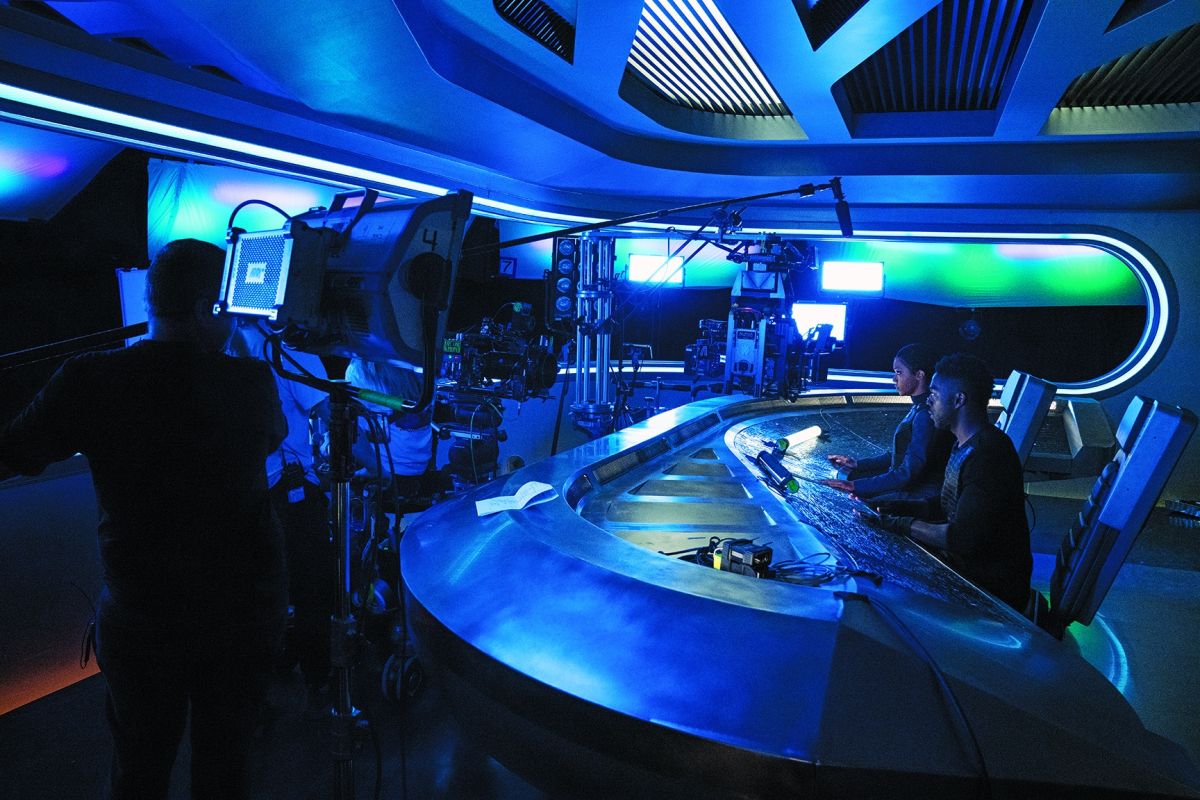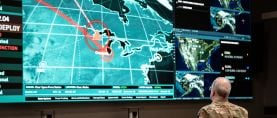
Outer Reaches: Star Trek: Discovery
Cinematographer Crescenzo Notarile, ASC, AIC makes his mark on an iconic universe.
“I love exploring new worlds,” says cinematographer Crescenzo Notarile, ASC, AIC. “Star Trek is another world of cinematography for me. A brave new world. A world of celestial tapestries, dark limbos filled with alien planets, spaceships in the galaxy causing time warps and combustions of energies that even bring us onto different timelines.”
The spirit of Star Trek — in this case, Star Trek: Discovery on Paramount Plus — is “to boldly go.” And Crescenzo (who prefers to be known by his first name only, “like Madonna, like Sting”) is a good match — a bold spirit with decades of stylistically striking commercial, television and music video credits to his name. Crescenzo was asked to join the show for five episodes in its third season, after earning two ASC Award nominations and one Emmy nomination for his expressively bold work on the Fox series Gotham. He had worked with guest director Olatunde Osunsanmi on Gotham, who became a producer-director on Star Trek: Discovery. “We shared a mutual respect from the beginning,” says Crescenzo, who shared duties with series lead cinematographer Glen Keenan, CSC.

The pilot for Discovery was shot by Guillermo Navarro, ASC, AMC in a style recalling the slick photography of the Trek reboot theatrical films photographed by Dan Mindel, ASC, BSC, SASC. The first two seasons of Discovery are set 10 years prior to the events of Star Trek: The Original Series (shot primarily by Gerald Perry Finnerman, ASC), and the third season rockets 900 years into the future. The show’s widescreen visual style, established by Navarro, is shot in 2.39:1 with Arri Alexa SXT cameras paired with Cooke Anamorphic /iSF lenses.

Says Crescenzo, “The show was already on its feet when I came in, and at first, confronted with an army of geniuses and ‘Trekkies’ — or ‘Trekkers’ — I just wanted to make my days and survive my new language. I was taking my cues from [executive producer] Alex Kurtzman — the ‘Wizard of Oz’ of that franchise and my personal creative steering wheel — along with my cinematography partner, Glen; gaffer Heinz Gloss; key grip Bob Daprato; chief camera assistant Andrew Stretch; [lighting] designer Franco Tata; and the consummately professional crewmembers, who were already there when I arrived, and were waiting for me to use creative courage to put my personal stamp on the show. I just didn’t want to rock the boat. I was blessed to have Star Trek actor-turned-director Jonathan Frakes as my first director; he nestled me into his heart and guided my spirit. It was an immediate kinship of many sorts.”

Crescenzo soon felt confident that he “wanted to go further with color, lens flares, light and personal camera compositions. A lot of the time we’re using in-camera effects: filters, prisms, probe lenses and shakers. I’ll use a piece of beveled glass in front of the lens and then flash the glass with a handheld Xenon flashlight.”
After extensive conversations, Ron Engvaldsen at Schneider Optics designed some specialty streak filters that allowed Crescenzo to change the color of his lens flares and control their effects. Prisms by Schneider and pieces of rummaged beveled glass were used in front of the lens to bend and distort the image during moments of intense drama or combat. “Sometimes I’d just get myself a colored gel, crinkle it up and tape it to the front of the beveled glass,” says the cinematographer. “But you’ve got to know when to go hard and when to back off. If it’s a more delicate, pensive or intimate scene, I’ll settle down to respect the words and the dramaturgy.”
Crescenzo’s camera floats and rolls through production designer Phillip Barker’s widescreen-friendly sets, an approach that conveys the feel of the USS Discovery moving through space. Says the cinematographer, “We always had an Alpha head on a Technocrane or on a Fisher dolly, and we sometimes used a Libra head as well, all to move and roll the camera. Otherwise, I would always be on Tangos or Dutch heads, so we could be spontaneously prepared to accentuate the geometry of the sets by dutching — giving us a subconscious feel of ‘Trekian’ style and flight.” When a ship rocks from being hit, Crescenzo used Clairmont Image Shakers from Keslow Camera, “to make it feel as physical as possible, like you were in the bowels of the ship being blasted.” Days on the Discovery bridge were heavy with Steadicam, high page counts and up to four cameras. “This became very compromising for proper lighting, but the scenes were very visceral, enough to take that onus away, objectively.”
The Cooke Anamorphic /i SF lenses were chosen for their flaring and bokeh qualities, which Crescenzo enhanced by placing pin sources of light in the background of shots “so the optic flares would dance and spark in a wonderful sort of impressionistic way.”
Crescenzo’s favorite lens was the 65mm macro for close focus, especially for close-ups of the cast, because it “rounds the face in a very intimate and personal way, and strengthens the physiognomy,” he says. “T2.8 is the sweet spot. The background softens in an impressionistic way and produces a beautiful and tactile bokeh. The only time I’d increase my stop was if I was on a longer lens, shooting against a star-field backdrop. The pinpoints of star lights distort if they go out of focus, and you have to be very careful about this with anamorphic lenses, because the round stars or moons go oval in shape — not round — unlike how they would with spherical lenses.”

As lighting plays a significant role in realizing the science-fiction elements of Discovery, the set incorporated as many as 5,000 DMX-controlled LED units. “My favorite light on this show is the Arri SkyPanel, because we can use it for almost anything,” says Crescenzo. “When the ship goes into alert mode, I can make them flicker, pulse and change color. For a close-up, I can use a SkyPanel S30 and a frame of Light Grid Cloth. If we needed fire or strobe lighting, it was quick to program on this unit — and I work very spontaneously, so this is a versatile tool for me!”
Particular to deep-space travel are the absence of day or night, and the difference in quality of light on a ship depending on its orientation in space. Crescenzo spotted T12s and 20Ks, along with occasional tungsten beam projectors gelled with CTS, through the Discovery Ready Room windows to produce strong, directional shafts of warm starlight. Windows on the dark side of the ship received soft, cool light from SkyPanel S120s and S60s, or reflected T12 Fresnels gelled cyan with ¾ CTB and ½ Plus Green. A thin layer of “special-effect smoke haze shaped the hard beams graphically,” Crescenzo says, and further softened the glowing light.

Discovery makes use of extensive prosthetic makeup to depict strange alien beings from the far corners of the galaxy. One of these — Doug Jones’ Saru — captains the Discovery and occupies a significant amount of screen time in Season 3. The actor’s entire face is covered with thick, grooved, sculptural skin. Lighting Saru was a challenge because of the dimensionality of his face,” Crescenzo says. “If I light from the side, I can’t see his eyes with all the prosthetic layers around them, [so instead] I’ll bring the light more to the front, lowering the angle and softening it, using a small S30 SkyPanel, double spaced and diffused with an opal frame, and with ¼ Grid Cloth to reduce the contrast. Soft light reaches more into the shadows of the prosthetics, thus giving a better tonal range of values to appreciate the prosthetics. Sometimes, I would run in at the last minute while the camera was rolling and hand-hold an LED ‘stick light’ just under the camera lens, to add twinkle to his green-contacted eyes and bring out the soul of his character.”
“You have to light the faces beautifully, even though some are meant to be menacing.”

Season 3 also sees the return of the green-skinned Orion race. Crescenzo approached lighting Janet Kidder’s character, Osyraa, as he would a fashion model — from the front and overexposed — so that her emerald complexion would appear to glow and blow out the imperfections of the prosthetics. Eyelight for all of the actors’ close-ups came from custom 1' and 2' sticks of LiteRibbon LEDs in milk acrylic, held above or below the camera’s matte box. “You have to light the faces beautifully, even though some are meant to be menacing,” he says.

Crescenzo overexposed all of his work on Star Trek: Discovery — up to a full stop, in some cases — with the intention of capturing extra shadow detail and pulling it down in the final color grade, “so the blacks become blacker and inkier and the pixels become tighter,” he says. He started with the default Arri K2S2 LUT and tweaked it from there, “while mostly shooting at an ISO of 800, splitting the latitude of highlights and shadows,” he says.
“My number-one tool in the online is the vignette,” says Crescenzo, who collaborated on the timing remotely with final-grade colorist Todd Bochner of Sim. “The dark edges from vignetting bring out the third dimension — the depth — and the center of the image comes toward you. I’ll try to shape the frame edges on set when I have the opportunity. But on an episodic schedule, with an abundant page count, I’m not going to take 15 extra minutes to set flags when I know I can do it in my final grade! Cinematographers should know their tools — not just on set, but also in postproduction.”






